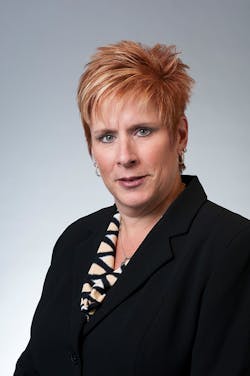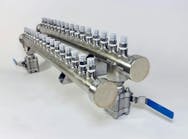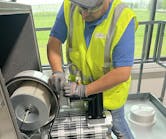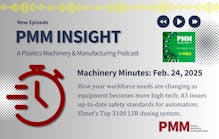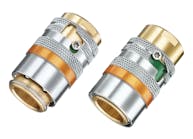How you feel about the 25 percent tariff that the U.S. government recently re-imposed on Chinese molds imported to the U.S. likely depends largely on where you sit in the supply chain, according to manufacturing consultant Laurie Harbour. Various market factors, including a slower and less predictable automotive market, continue to make life challenging for U.S. mold makers, she said.
Related story: The industry reacts to the ups and downs of the trade war
“If I’m a plastic molder,” said Harbour, president and CEO of Southfield, Mich.-based Harbour Results Inc. (HRI), “I don't love the tariff on tooling, for example, but I love the tariffs on parts, because that means somebody might have me make parts instead.”
Tariffs and trade uncertainty have been top of mind for many experts like Harbour, who warns that the U.S. is at a competitive disadvantage with lower-wage countries.
Laurie Harbor is a manufacturing consultant.On July 6, 2018, the U.S. government placed a tariff on Chinese molds. It then granted a 12-month exclusion from the tariffs for U.S. importers on December 28, 2018, before reinstating the tariff on Dec. 28, 2019. “So, they’re happier now than they were all of last year,” Harbour said of many U.S. mold makers, “because they lost a lot of business to China.”
Harbour works to document the impact of trade and various market forces on U.S. mold makers. Her clients include the American Mold Builders Association (AMBA), which asserts that Chinese mold makers dump their products in the U.S. A fact sheet issued by HRI on behalf of the AMBA declares, “Chinese-owned shops sell molds and dies to U.S. manufacturers up to 40 percent below the cost of molds produced in a domestic shop.”
The initial U.S. tariffs in July 2018 applied to $34 billion worth of Chinese imports, including molds and mold bases. The HRI fact sheet states: “Chinese mold shops reported a significant drop in revenue (10 to 30 percent) primarily as a result from the U.S.-imposed tariffs. U.S.-based mold shops benefited from a more level playing field and won a greater number of tooling packages.”
When the Trump administration suspended the tariff in December 2018, it cited a lack of capacity at U.S. mold shops as the reason that manufacturers needed to look abroad for tooling. But, said AMBA, citing HRI data: “This is inaccurate, as U.S. mold capacity in 2018 ranged from a high of 81 percent to a low of 77 percent — proving that capacity is not an issue.”
The real issue driving manufacturers to source molds from China, according to AMBA, is price.
One mold maker’s perspective
Roger Klouda, president of MSI Mold Builders in Cedar Rapids, Iowa, said that initially, the 25 percent tariff imposed in 2018 gave his 49-year-old firm a boost.
“When they put the tariffs on, right away there was a spike of about $2 million in sales for us in the first two months,” he said. “Programs were going to go to China, and when the tariffs came on, they got re-sourced in the United States.”
He said that MSI — one of the country’s largest non-automotive mold makers — always strives “to be within 25 percent of the Chinese price, because most people at that level just won’t go to China. It’s just not worth it.”
The tariffs have made many molders think hard about whether it’s worth going to China for a diminished price break, he said. One customer “has told us to expect to get more work because now we’ll be more competitive. It hasn’t developed into any more work … yet. But we are quoting more for this customer than we have previously,” he said.
Asked whether the heightened sense of uncertainty around the economy has affected business much, Klouda was dismissive. He noted that the strong economy seems to indicate that the markets have learned to shrug off some of the day-to-day volatility in the news.
One factor that annoys Klouda is how brazenly the Chinese “cheat,” as he put it, to circumvent the current tariff. Chinese mold makers are very active in marketing their services, and they do a lot of unsolicited outreach to all types of firms — including other mold makers — to see if they can stir up new business. Those efforts sometimes succeed, with Chinese mold makers often making molds or mold components for U.S. shops.
MSI has never bought any tools or mold bases from China, but rather than just ignore Chinese mold makers’ attempts to reach him, Klouda sometimes responds, just to see what they’ll say.
“Every time I get a solicitation from a Chinese shop, I ask them what they’re going to do [regarding their pricing because of the tariff], and it’s amazing that they are willing to put in an email exactly how they cheat. I’m gathering all these, and so are some of my friends, and we’re going to present them to the USTR [Office of the U.S. Trade Representative], and say, ‘You know, this is the crap we fight every day.’ ”
He shared several of the emailed responses he got with PMM to prove his point.
Roger Klouda is president of MSI Mold Builders in Cedar Rapids, Iowa.Harbour Results Inc.Chinese firms’ workarounds
- One mold maker, from Dongguan, wrote: “As for the tariffs, our quotation engineer will quote the tool cost by two part, one is for the Mold Design Cost, Another is for the Mold Cost. When we export the tool, we can only fill in the Mold Cost in the Commercial Invoice. It can reduce the tax cost once you import the tool from China. All of our United [States] Customer solve this problem in this way.”
- Another Dongguan-based firm responded similarly: “For tariff, we can separate the mold design cost and mold construction cost, and have a lower value for custom, thus to lower the tariff.”
- A tool shop based in Shenzhen wrote: “About the tariffs, we think first Mr. Trump and our Mr. Xi will have a good cooperation soon, and the tariffs will be reduced. Before this happen, normally we ship the mold to Malaysia by sea, then make the custom clearance, then transfer the mold from Malaysia to USA.”
- And another firm in Shenzhen wrote: “Here are the common practice of avoiding tariffs currently: 1) We under-report the value, to help our costomers to avoid the high import duties. 2) We ship the goods to Canada and then trans-ship them to the United States.”
Additionally, Klouda said he has OEM friends who manufacture plastic products in China who tell him, “I’m going to move my tools to Malaysia, I’m going to move my tools to Vietnam — but,” those OEMs acknowledge, “you can’t move all that manufacturing out of China and into Vietnam in the next two months and expect to have any quality, or anything else. It’s just one more low-cost country to another; we’ll just follow the cheap labor.”
Impact of the USMCA
Neither Harbour nor Klouda believe the United States-Mexico-Canada Agreement (USMCA), which is a revision to the North American Free Trade Agreement, will have much effect on U.S. mold makers, once it’s ratified by Canada.
Harbour said she believes it will have a bigger impact on automakers and Tier 1 suppliers, which will have to meet certain higher wage requirements for their workers in Mexico. But, “I don’t see it affecting tool makers and/or the smaller plastics processors of the world,” she said.
Klouda agreed the USMCA will have little impact on firms such as MSI but noted that “the exchange rate with Canada is now probably the bigger issue for us right now. That’s a biggie, because there’s a lot of mold making in Canada.”
With the value of the Canadian dollar being about 25 percent less than that of the U.S. dollar, some of the costs for Canadian mold makers — primarily labor — are lower than for U.S. firms. Tool shops in Canada may source many of their components and materials from the U.S., and as such those are quoted in U.S. dollars. Some view this exchange rate disparity as just another obstacle that U.S. mold makers face.
No silver bullet
Harbour, meanwhile, had a message for her mold-making clients. “On the [plastic] part and the tool side, the Chinese are just going to get more aggressive. This tariff stuff is no silver bullet.”
She tells her various clients: “You guys have got to figure out how to become more competitive on an ongoing basis. You can’t sit back on your laurels, because the Chinese will continue to be more competitive than ever before. They’re not going to give up this market.”
In November, HRI released the findings of its latest in-depth study on the current state of the automotive vendor tooling industry. The analysis predicts that the amount automotive vendors will spend on tooling in North America this year will drop to $6.8 billion from an estimated $8.7 billion last year. Harbour notes that 60 to 70 percent of the data compiled in the study relates to plastics mold making, with more than 400 shops in the U.S. specifically making molds for the North American automotive industry.
HRI further predicts that automotive tooling spending in North America will drop from an annual average of $8 billion to $10 billion down to just $6.5 billion to $8 billion for each of the next three to five years.
“This forecast is difficult for us to share. We are passionate about helping the North American manufacturing industry remain competitive. However, the ongoing marketplace change and competition from low-cost countries — specifically China — has already impacted tool and die makers. In 2019, we saw at least 10 shops close and more than 2,000 workers laid off, and we see this trend continuing,” Harbour said.
She noted that “the outlook for mold makers is more grim than for die makers,” whose numbers are far fewer in North America, with perhaps only 100 die makers or so in the region.
Harbour said that most of the 2,000 layoffs her firm documented were in mold making, “and we know it’s higher than that number, but we were not able to document every shop in the country.”
“The Chinese are not going away just because we put a tariff in place,” she said.
Robert Grace, contributor


